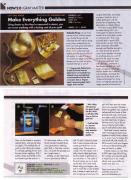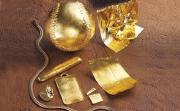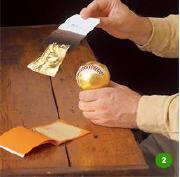| Make Everything GoldenUsing sheets so thin they're measured in atoms, you can cover anything with a lasting coat of pure gold. |
| |
|
| |
Malleable things can be hammered thinner without breaking; ductile things can be stretched thinner without snapping. Every material has its limit, but with gold, that limit is just a few hundred atoms thick. Gold is the most malleable and the most ductile of all metals. A cube of it about 21/2 inches on edge could be beaten out to cover an entire football field (at a cost of roughly $68,000, plus beating fees). Gold this thin is called gold leaf, and the ancient art of applying it for decoration is called gilding.
How thin is gold leaf? Using my steel rolling mill, I can make gold foil about one thousandth of an inch thick, similar to aluminum foil. Thin, sure, but gold leaf is nearly 500 times times as thin as that. Only then does it become affordable enough and flexible enough to be used almost like paint to cover finely detailed carvings or anything else you want to be shiny for years to come.
To make gold leaf, start with gold foil, interleave a few dozen squares of it with layers of special vellum (so the foil sheets don't stick to one another), and beat the heck out of the stack with a 16-pound hammer for many hours, turning the squares into larger squares of thinner foil. Then cut the sheets in quarters, restack them, and pound them out again. The malleability of gold is what allows the sheets to just keep getting thinner and thinner without splitting. (OK, I admit, I tried and failed at this. Just haven't got the arm for it. Or the proper vellum, or the family secrets handed down over generations. Making gold leaf is, like other ancient arts, not quite the garage project it might seem.)
Gilding, on the other hand, is not a particularly difficult skill. To gild a home-run baseball, I used commercially prepared gold leaf from an art-supply store. The process is simple: Paint the object with a sticky liquid called gold size, lay the sheets of gold leaf on, and rub them in. The catch is the part where you try to pick up the leaf. Don't even think about using your fingers-this stuff is more like a soap bubble than a sheet of metal and will start wrapping around your fingers and then tear the instant you try to unwrap it. Brushes known as gilders' tips, made of red-squirrel hair (none of that gray-squirrel crap, mind you) are used to pick up the sheets by static electricity. It takes a delicate touch, but at $2 per four-inch-by-four-inch sheet, you're motivated to learn fast.
Gold leaf instantly welds to itself. Overlapping layers fuse together invisibly when rubbed in, so even if you're sloppy, the end result will look smooth. It's OK to touch it with your fingers at this point because the gold size will hold it in place.
Gilded objects survive from 5,000 years ago (think King Tut's mask), proving that gold is impervious to air, water, alkalis and most acids, no matter how thin it is.
Scan of printed version:
 |
| |
|
| |
|
| |


Mini rolling mill squeezes one gram of gold into foil, which is still about 500 times as thick as gold leaf.

Gold leaf held to a squirrel-hair brush by static electricity, ready to be applied.
Photo Credits:
Charles Shotwell
Charles Shotwell
Charles Shotwell
|
|